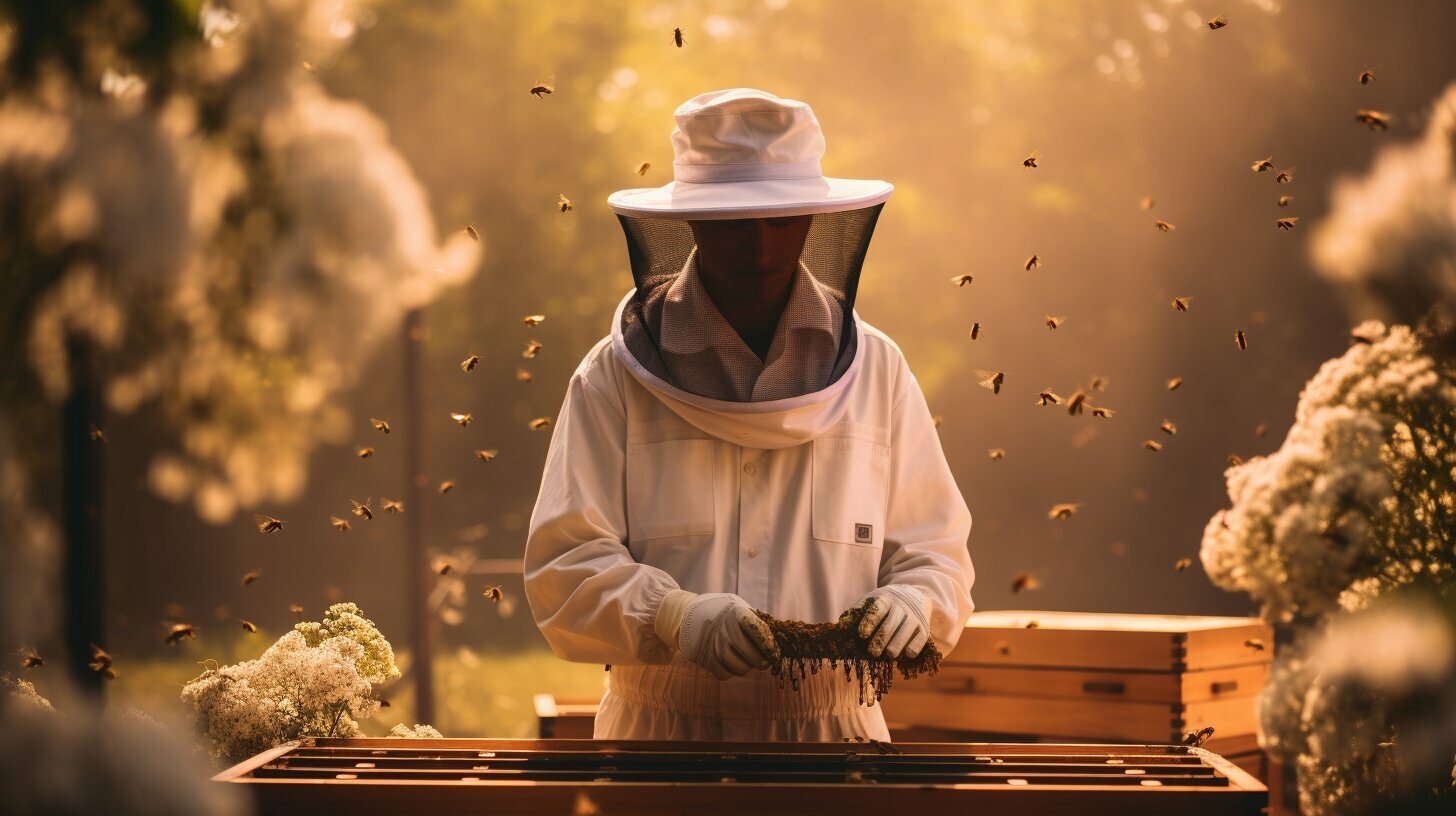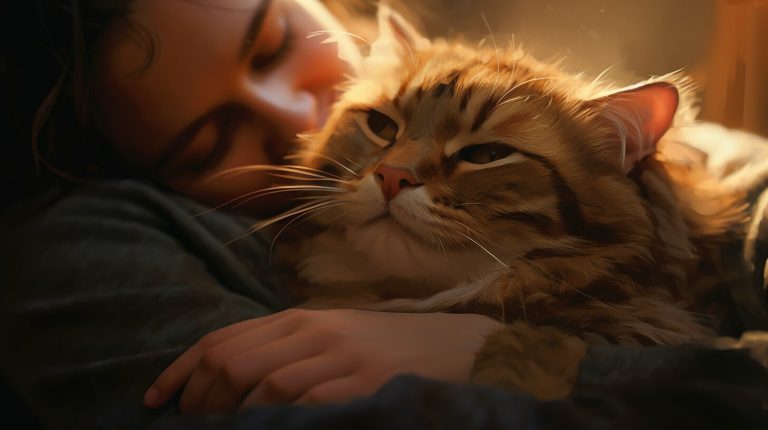Why Do Beekeepers Wear White?
Have you ever wondered why beekeepers don white clothing while tending to their buzzing hives? Beekeepers primarily wear white suits for several reasons. Firstly, bees have a natural instinct to associate dark colors with predators, and wearing black or other dark colors can increase the likelihood of bee attacks. Bees are known to detect colors five times faster than human beings, so they are quick to perceive potential threats. Secondly, white suits reflect bright sunlight, keeping beekeepers cooler during hot summer months when beekeeping is most active. Darker colors would absorb more heat and make beekeeping uncomfortable.
Additionally, the mesh fabric in beekeeping veils is typically black to ensure clear visibility for the beekeeper, even though black can trigger aggression in bees. While white is the most common color for bee suits, lighter shades like khaki or yellow can also be used as long as they provide good visibility and reflect light. It’s important to note that colors alone cannot prevent bee stings, and bee behavior is influenced by various other factors such as hive conditions and human activities.
Key Takeaways:
- Beekeepers wear white clothing to minimize the risk of bee attacks, as bees associate dark colors with predators.
- Bees have heightened color perception and quickly detect potential threats.
- White suits reflect sunlight, keeping beekeepers cooler during hot summer months.
- Lighter shades like khaki or yellow can also be used as long as they provide good visibility and reflect light.
- Colors alone cannot prevent bee stings, and bee behavior is influenced by hive conditions and human activities.
The Importance of Color in Beekeeping Attire
Bees possess a remarkable ability to associate dark colors with potential threats, making the choice of clothing color crucial for beekeepers. These tiny creatures have a heightened color perception, detecting colors five times faster than humans. Therefore, it is no surprise that beekeepers opt for white clothing in their beekeeping practice.
By wearing white suits, beekeepers minimize the risk of bee attacks. Bees naturally view dark colors as indicators of predators and are more likely to become defensive or aggressive in their presence. The use of white clothing helps create a sense of calm and reduces the chances of attracting unwanted attention from the bees.
Aside from its significance for bee behavior, the choice of white clothing also offers practical benefits for beekeepers. White suits reflect bright sunlight, keeping beekeepers cooler during the hot summer months when beekeeping activities are at their peak. Darker colors, such as black, would absorb more heat and make the beekeeping experience much more uncomfortable.
While white is the predominant color choice for bee suits, lighter shades like khaki or yellow can also be used. These colors provide good visibility and effectively reflect light, serving the same purpose as white clothing. The mesh fabric used in beekeeping veils, however, is typically black to ensure clear visibility for the beekeeper.
| Highlight: | Bees associate dark colors with predators, leading to increased risk of attacks. |
|---|---|
| Practical Benefit: | White clothing reflects sunlight, keeping beekeepers cooler during hot summer months. |
| Alternative Choices: | Lighter colors like khaki or yellow can also be used, as long as they provide good visibility and reflect light effectively. |
The Significance of White Clothing in Beekeeping
The significance of white clothing in beekeeping goes beyond simply aesthetic considerations. Beekeepers primarily wear white suits for several reasons. Firstly, bees have a natural instinct to associate dark colors with predators, and wearing black or other dark colors can increase the likelihood of bee attacks. Bees are known to detect colors five times faster than human beings, so they are quick to perceive potential threats.
Secondly, white suits reflect bright sunlight, keeping beekeepers cooler during hot summer months when beekeeping is most active. Darker colors would absorb more heat and make beekeeping uncomfortable. Additionally, the mesh fabric in beekeeping veils is typically black to ensure clear visibility for the beekeeper, even though black can trigger aggression in bees.
While white is the most common color for bee suits, lighter shades like khaki or yellow can also be used as long as they provide good visibility and reflect light. It’s important to note that colors alone cannot prevent bee stings, and bee behavior is influenced by various other factors such as hive conditions and human activities.
Comfort and Reflectivity in Beekeeping Attire
Wearing white clothing in beekeeping not only serves a functional purpose but also ensures beekeepers can work comfortably in various weather conditions. Beekeeping is a labor-intensive activity that requires long hours of work, often in hot and humid environments. The choice of clothing is crucial in providing comfort and protection for beekeepers.
One of the main benefits of wearing white suits is their ability to reflect bright sunlight. As bees are highly sensitive to colors, especially dark ones, wearing white suits helps minimize the risk of bee attacks. Darker colors, such as black or brown, can be mistaken as a potential threat by bees, increasing the likelihood of aggression. In contrast, the reflective nature of white clothing keeps beekeepers cooler by reducing the absorption of heat.
Moreover, the use of breathable and lightweight fabric in white suits allows for better ventilation, preventing excessive heat buildup and allowing sweat to evaporate more easily. This ensures that beekeepers can work comfortably, even during the hottest summer months when bee activity is at its peak.
| Benefits of Wearing White in Beekeeping |
|---|
| Reflects bright sunlight, keeping beekeepers cooler |
| Minimizes the risk of bee attacks by reducing the association with predators |
| Breathable and lightweight fabric allows for better ventilation |
While white is the most common color for bee suits, lighter shades like khaki or yellow can also be used as long as they provide good visibility and reflect light effectively. The primary goal is to ensure that beekeepers remain safe and comfortable while working with bees. It’s important to note that colors alone cannot prevent bee stings, and bee behavior is influenced by various other factors such as hive conditions and human activities.
In conclusion, the choice of clothing in beekeeping goes beyond aesthetics. White clothing offers practical benefits such as comfort and reflectivity, which contribute to the overall safety and well-being of beekeepers. By understanding the significance of white suits and their impact on bee behavior, beekeepers can work confidently and effectively in their beekeeping practices.
Alternatives to White Beekeeping Suits
While white is the most commonly used color for beekeeping suits, there are alternative options for beekeepers to consider. Lighter shades like khaki or yellow can also provide good visibility and reflect light effectively.
The Benefits of Khaki Beekeeping Suits
Khaki suits offer a practical alternative to traditional white beekeeping attire. The light brown color of khaki is less likely to trigger aggressive behavior in bees, as they do not associate it with predators. Additionally, khaki suits are less likely to absorb heat, making them a comfortable choice for beekeepers working in hot weather.
The Advantages of Yellow Beekeeping Suits
Yellow suits are another popular choice for beekeepers. Bees are less likely to perceive yellow as a threat, which reduces the risk of bee attacks. The bright color of yellow also increases visibility for both the beekeeper and the bees, making it easier to navigate and work with the hives.
| Color | Advantages |
|---|---|
| Khaki | – Less likely to trigger aggression in bees – Offers comfort in hot weather |
| Yellow | – Reduces the risk of bee attacks – Increases visibility for beekeeper |
Ultimately, the choice of color for beekeeping suits is a personal preference. Whether it’s white, khaki, or yellow, the most important factors to consider are visibility, heat absorption, and minimizing the risk of bee stings. Beekeepers should choose a suit that suits their needs and provides them with comfort and protection during their beekeeping practices.
Beekeeping Veils: A Necessary Component
Beekeeping veils play a vital role in ensuring the safety of beekeepers, even though they may seem counterintuitive at first. While the rest of the beekeeping suit is usually white to minimize the risk of bee attacks, the mesh fabric in the veil is typically black. This design choice may raise eyebrows, but it serves a crucial purpose.
The black mesh fabric used in beekeeping veils ensures clear visibility for the beekeeper. It allows them to see their surroundings and the bees without obstruction. This is essential for maintaining control and awareness while working with the hives. However, it’s worth noting that black can potentially trigger aggression in bees. To mitigate this risk, the veil is designed with enough distance from the face, providing a barrier between the beekeeper and the bees.
Other components of the beekeeping attire, such as the white suit and gloves, provide protection against bee stings, but the veil is specifically designed to prevent bees from coming into contact with the face and neck. These areas are particularly sensitive and vulnerable to stings. By wearing a veil, beekeepers significantly reduce the risk of being stung on the most delicate parts of their body.
When it comes to beekeeping safety attire, each component plays a crucial role in protecting beekeepers from potential harm. The veil may seem unconventional with its black mesh fabric, but it serves a vital purpose in ensuring clear visibility and preventing bee stings on the face and neck. By using the appropriate safety gear like veils, beekeepers can confidently work with their bees, knowing they have taken the necessary precautions to stay safe.
| Component | Purpose |
|---|---|
| White Suit | Minimizes the risk of bee attacks by avoiding association with predators. |
| Gloves | Provides protection against bee stings on the hands and wrists. |
| Beekeeping Veil | Prevents bee stings on the face and neck while ensuring clear visibility for the beekeeper. |
Additional Factors in Bee Behavior
While the choice of clothing color is significant, bee behavior is influenced by various other factors that beekeepers must consider. Understanding these factors can help beekeepers minimize the risk of bee stings and create a safer environment for themselves and their bees.
Hive Conditions: The condition of the hive plays a crucial role in bee behavior. Bees are more likely to become defensive and aggressive if they perceive a threat to their colony. Factors such as overcrowding, lack of food or water, and disturbances to the hive can trigger defensive behaviors. Regular hive inspections, maintaining appropriate hive space, and providing a sufficient food supply can help keep bee behavior in check.
Human Activities: Beekeepers must be mindful of their actions when handling their bees. Rapid movements, excessive noise, and strong scents can all agitate bees and lead to defensive behavior. It’s important to approach beehives calmly, move slowly and deliberately, and use proper techniques when working with the bees. Avoid using strong perfumes or colognes, as these can also trigger defensive responses from the bees.
Protective Clothing: While the color of beekeeping attire is important, the design and quality of the clothing also play a vital role in beekeeper safety. Protective clothing, including bee suits, veils, and gloves, should be made of durable materials that provide adequate coverage. Properly fitted gear ensures that bees cannot penetrate the clothing, reducing the risk of stings. Regular inspection and maintenance of beekeeping attire are essential to ensure its effectiveness and protect beekeepers from potential harm.
| Factors Influencing Bee Behavior | Ways to Mitigate Risks |
|---|---|
| Hive Conditions | – Conduct regular hive inspections – Maintain appropriate hive space – Provide sufficient food and water |
| Human Activities | – Approach hives calmly – Move slowly and deliberately – Avoid strong scents and perfumes |
| Protective Clothing | – Use high-quality, durable clothing – Ensure proper fit and coverage – Regularly inspect and maintain gear |
Conclusion
The choice of white clothing in beekeeping is driven by multiple factors, including visual cues for bees, comfort for beekeepers, and the need for protective gear. Beekeepers primarily wear white suits to minimize the risk of bee attacks, as bees associate dark colors with predators. Bees have heightened color perception and can detect potential threats five times faster than humans. By wearing white, beekeepers can reduce the chances of triggering aggression in bees, allowing them to work more safely and efficiently.
White suits also offer practical benefits in beekeeping. They reflect bright sunlight, keeping beekeepers cooler during hot summer months when beekeeping activities are at their peak. Darker colors would absorb more heat and make beekeeping uncomfortable. Additionally, the mesh fabric used in beekeeping veils is often black to ensure clear visibility for the beekeeper, despite the risk of aggravating the bees. Lighter shades of clothing, such as khaki or yellow, can be used as alternatives to white as long as they provide good visibility and reflect light effectively.
However, it’s important to note that while clothing color is an important consideration, it is not the sole determining factor in preventing bee stings. Bee behavior is influenced by various other factors, including hive conditions and human activities. Proper hive management and cautious beekeeping practices are crucial for reducing the risk of bee stings. Beekeepers must also wear protective gear, including gloves and sturdy footwear, to ensure their safety and minimize the chances of being stung.
In conclusion, the choice of white clothing in beekeeping serves multiple purposes. It provides visual cues for bees, keeping them calm and less likely to attack. It offers comfort to beekeepers by reflecting sunlight and keeping them cool. It also serves as a form of protective gear, minimizing the chances of bee stings. While beekeepers can explore lighter shades of clothing, white remains the most common and effective color choice. By understanding the significance of white clothing and considering other safety measures, beekeepers can engage in their practice with confidence and safety.
FAQ
Why do beekeepers wear white?
Beekeepers primarily wear white suits for several reasons. Firstly, bees have a natural instinct to associate dark colors with predators, and wearing black or other dark colors can increase the likelihood of bee attacks. Bees are known to detect colors five times faster than human beings, so they are quick to perceive potential threats. Secondly, white suits reflect bright sunlight, keeping beekeepers cooler during hot summer months when beekeeping is most active. Darker colors would absorb more heat and make beekeeping uncomfortable. Additionally, the mesh fabric in beekeeping veils is typically black to ensure clear visibility for the beekeeper, even though black can trigger aggression in bees. While white is the most common color for bee suits, lighter shades like khaki or yellow can also be used as long as they provide good visibility and reflect light. It’s important to note that colors alone cannot prevent bee stings, and bee behavior is influenced by various other factors such as hive conditions and human activities.
What is the significance of white clothing in beekeeping?
White clothing in beekeeping serves multiple purposes. It helps minimize the risk of bee attacks by not triggering their instinctual response to dark colors associated with predators. Additionally, white suits reflect sunlight, keeping beekeepers cooler during hot summer months. White clothing also provides a level of protection for beekeepers, as it allows them to easily spot any bees that may have landed on their suit. While white is the most common color choice, lighter shades like khaki or yellow can also be used as long as they provide good visibility and reflect light effectively.
Why is wearing white important in beekeeping?
Wearing white in beekeeping is important because it helps prevent bee attacks. Bees have a natural association between dark colors and predators, so wearing black or other dark colors can increase the likelihood of bee aggression. By wearing white, beekeepers reduce their chances of being mistaken for a threat and triggering a defensive response from the bees. Additionally, white clothing reflects bright sunlight, keeping beekeepers cooler during hot summer months and providing comfort during their beekeeping activities.
Are there alternatives to white beekeeping suits?
While white is the most common color choice for beekeeping suits, there are alternatives available. Lighter shades like khaki or yellow can be used as long as they provide good visibility and reflect light effectively. The goal is to avoid dark colors that could be mistaken for predators by bees. Ultimately, the most important aspect of beekeeping attire is to ensure it offers adequate protection and comfort for the beekeeper.
Why do beekeeping veils use black mesh fabric?
Beekeeping veils use black mesh fabric because it offers clear visibility for the beekeeper. Black mesh provides a contrast against the surrounding environment, making it easier for beekeepers to see through the veil while working with the bees. However, it’s important to note that black can trigger aggression in bees, so the rest of the beekeeping suit should still be white or a lighter color. The use of black mesh is a balance between visibility for the beekeeper and minimizing potential aggression from the bees.
What other factors influence bee behavior aside from clothing color?
While clothing color is important in beekeeping, it is not the sole determining factor in preventing bee stings. Bee behavior is influenced by various other factors such as hive conditions and human activities. Bees can become more aggressive if they sense a threat to their hive, regardless of the color of the beekeeper’s suit. It’s important for beekeepers to practice good hive management and be aware of their actions to minimize potential aggression from the bees.
- Discovering Why Do Women Wear Lipstick: A Deeper Look - 19/12/2023
- Why Do Golfers Only Wear One Glove? - 16/12/2023
- Why Don’t Hobbits Wear Shoes? - 14/12/2023
Hi, I’m Rhiannon, the lead author behind The News Wire. As a passionate journalist, I strive to bring you the latest news and updates from all over the world. With a keen eye for detail and a dedication to unbiased reporting, I aim to deliver well-researched and informative articles that keep you informed and engaged. From breaking news to in-depth analyses, I cover a wide range of topics with the aim of keeping you in the loop. Join me on The News Wire as we explore the dynamic and ever-changing landscapes of global events, uncovering the stories that matter most.






